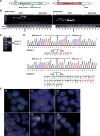Comprehensive analysis of the MYB-NFIB gene fusion in salivary adenoid cystic carcinoma: Incidence, variability, and clinicopathologic significance
- PMID: 20702610
- PMCID: PMC5862426
- DOI: 10.1158/1078-0432.CCR-10-0463
Comprehensive analysis of the MYB-NFIB gene fusion in salivary adenoid cystic carcinoma: Incidence, variability, and clinicopathologic significance
Abstract
Purpose: The objectives of this study were to determine the incidence of the MYB-NFIB fusion in salivary adenoid cystic carcinoma (ACC), to establish the clinicopathologic significance of the fusion, and to analyze the expression of MYB in ACCs in the context of the MYB-NFIB fusion.
Experimental design: We did an extensive analysis involving 123 cancers of the salivary gland, including primary and metastatic ACCs, and non-ACC salivary carcinomas. MYB-NFIB fusions were identified by reverse transcriptase-PCR (RT-PCR) and sequencing of the RT-PCR products, and confirmed by fluorescence in situ hybridization. MYB RNA expression was determined by quantitative RT-PCR and protein expression was analyzed by immunohistochemistry.
Results: The MYB-NFIB fusion was detected in 28% primary and 35% metastatic ACCs, but not in any of the non-ACC salivary carcinomas analyzed. Different exons in both the MYB and NFIB genes were involved in the fusions, resulting in expression of multiple chimeric variants. Notably, MYB was overexpressed in the vast majority of the ACCs, although MYB expression was significantly higher in tumors carrying the MYB-NFIB fusion. The presence of the MYB-NFIB fusion was significantly associated (P = 0.03) with patients older than 50 years of age. No correlation with other clinicopathologic markers, factors, and survival was found.
Conclusions: We conclude that the MYB-NFIB fusion characterizes a subset of ACCs and contributes to MYB overexpression. Additional mechanisms may be involved in MYB overexpression in ACCs lacking the MYB-NFIB fusion. These findings suggest that MYB may be a specific novel target for tumor intervention in patients with ACC.
©2010 AACR.
Figures



References
-
- Batsakis JG, Regezi JA, Luna MA, el-Naggar A. Histogenesis of salivary gland neoplasms: a postulate with prognostic implications. J Laryngol Otol. 1989;103:939–44. - PubMed
-
- Batsakis JG, Luna MA, el-Naggar A. Histopathologic grading of salivary gland neoplasms: III. Adenoid cystic carcinomas. Ann Otol Rhinol Laryngol. 1990;99:1007–9. - PubMed
-
- Garden AS, Weber RS, Morrison WH, Ang KK, Peters LJ. The influence of positive margins and nerve invasion in adenoid cystic carcinoma of the head and neck treated with surgery and radiation. Int J Radiat Oncol Biol Phys. 1995;32:619–26. - PubMed
-
- Glisson B, Colevas AD, Haddad R, et al. HER2 expression in salivary gland carcinomas: dependence on histological subtype. Clin Cancer Res. 2004;10:944–6. - PubMed
-
- Locati LD, Perrone F, Losa M, et al. Treatment relevant target immunophenotyping of 139 salivary gland carcinomas (SGCs) Oral Oncol. 2009;45:986–90. - PubMed
Publication types
MeSH terms
Substances
Grants and funding
LinkOut - more resources
Full Text Sources
Other Literature Sources
Medical

